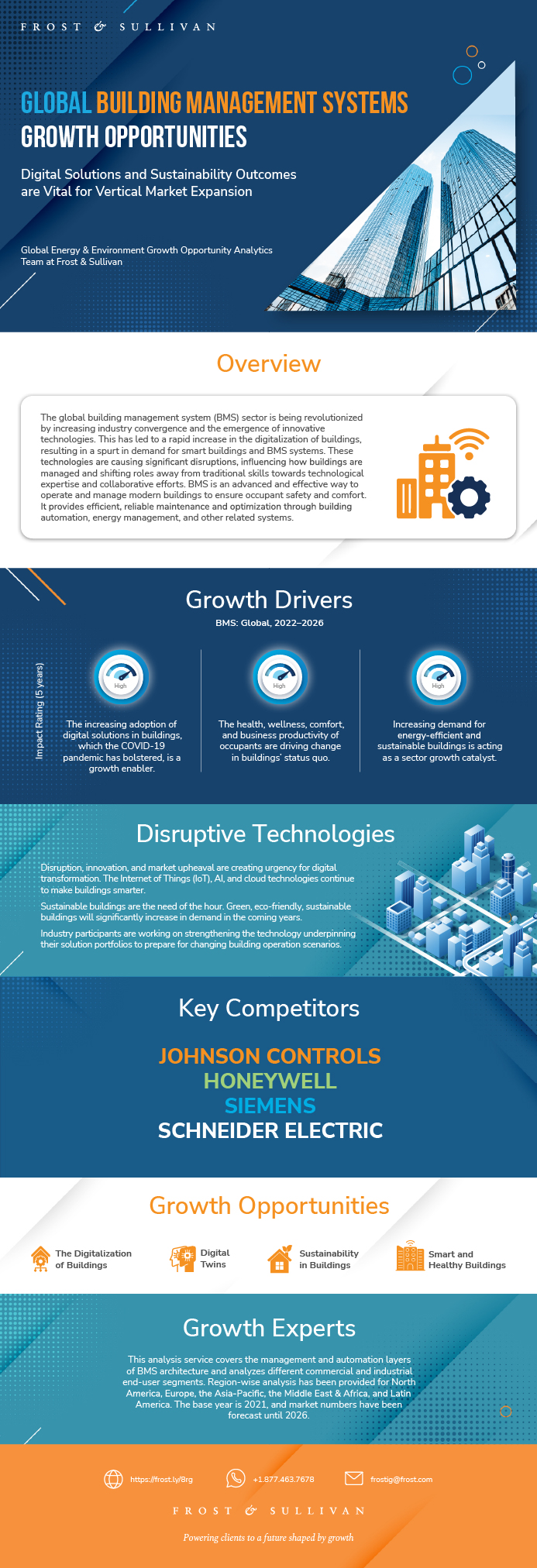Global Building Management Systems Growth Opportunities
Global Building Management Systems Growth Opportunities
Digital Solutions and Sustainability Outcomes are Vital for Vertical Market Expansion
05-Dec-2022
Global
$4,950.00
Special Price $4,455.00 save 10 %
Description
The global building management system (BMS) market is being revolutionized by increasing industry convergence and the emergence of innovative technologies. This has led to a rapid increase in the digitalization of buildings, resulting in a spurt in demand for smart buildings and BMS systems. These technologies are causing significant disruptions, influencing how buildings are managed and shifting roles away from traditional skills towards technological expertise and collaborative efforts.
BMS is an advanced and effective way to operate and manage modern buildings to ensure occupant safety and comfort. It provides efficient, reliable maintenance and optimization through building automation, energy management, and other related systems.
The global BMS market is on an upswing and is expected to have a compound annual growth rate (CAGR) of 7.9% from 2021 to 2026. COVID-19 has intensified the need for digitalization in buildings, placing a greater focus on the health and wellness of occupants. These factors, along with the increasing awareness for energy-efficient and sustainable buildings, act as a key growth accelerator for this market.
This research service covers the management and automation layers of BMS architecture and analyzes different commercial and industrial end-user segments. Region-wise analysis has been provided for North America, Europe, the Asia-Pacific, the Middle East & Africa, and Latin America. The base year is 2021, and market numbers have been forecast until 2026.
Author: Viswesh Vancheeshwar
RESEARCH: INFOGRAPHIC
This infographic presents a brief overview of the research, and highlights the key topics discussed in it.Click image to view it in full size

Table of Contents
Why is it Increasingly Difficult to Grow?
The Strategic Imperative 8™
The Impact of the Top 3 Strategic Imperatives on the Global Building Management System (BMS) Industry
Growth Opportunities Fuel the Growth Pipeline Engine™
Scope of Analysis
Segmentation
Key Competitors
Key Growth Metrics
Growth Drivers
Growth Driver Analysis
Growth Driver Analysis (continued)
Growth Driver Analysis (continued)
Growth Driver Analysis (continued)
Growth Restraints
Growth Restraint Analysis
Growth Restraint Analysis (continued)
Forecast Assumptions
Revenue Forecast
Revenue Forecast Analysis
Percent Revenue Forecast by Region
Revenue Forecast by Region
Revenue Forecast Analysis by Region
Percent Revenue Forecast by Vertical
Revenue Forecast by Vertical
Revenue Forecast Analysis by Vertical
Revenue Forecast Analysis by Vertical (continued)
Revenue Forecast Analysis by Vertical (continued)
Pricing Trends Analysis
Competitive Environment
Market Share Analysis
Key Growth Metrics
Revenue Forecast
Revenue Forecast by Vertical
Forecast Analysis
Key Growth Metrics
Revenue Forecast
Revenue Forecast by Vertical
Forecast Analysis
Key Growth Metrics
Revenue Forecast
Revenue Forecast by Vertical
Forecast Analysis
Key Growth Metrics
Revenue Forecast
Revenue Forecast by Vertical
Forecast Analysis
Key Growth Metrics
Revenue Forecast
Revenue Forecast by Vertical
Forecast Analysis
Growth Opportunity 1: The Digitalization of Buildings
Growth Opportunity 1: The Digitalization of Buildings (continued)
Growth Opportunity 2: Digital Twins
Growth Opportunity 2: Digital Twins (continued)
Growth Opportunity 3: Sustainability in Buildings
Growth Opportunity 3: Sustainability in Buildings (continued)
Growth Opportunity 4: Smart and Healthy Buildings
Growth Opportunity 4: Smart and Healthy Buildings (continued)
Your Next Steps
Why Frost, Why Now?
List of Exhibits
List of Exhibits (continued)
Legal Disclaimer
Popular Topics
| Author | Viswesh Vancheeshwar |
|---|---|
| Industries | Environment |
| No Index | No |
| Is Prebook | No |
| Keyword 1 | Global BMS Market |
| Keyword 2 | Smart Building Management System |
| Keyword 3 | automated building management |
| Podcast | No |
| WIP Number | PDC3-01-00-00-00 |
 USD
USD GBP
GBP CNY
CNY EUR
EUR INR
INR JPY
JPY MYR
MYR ZAR
ZAR KRW
KRW THB
THB